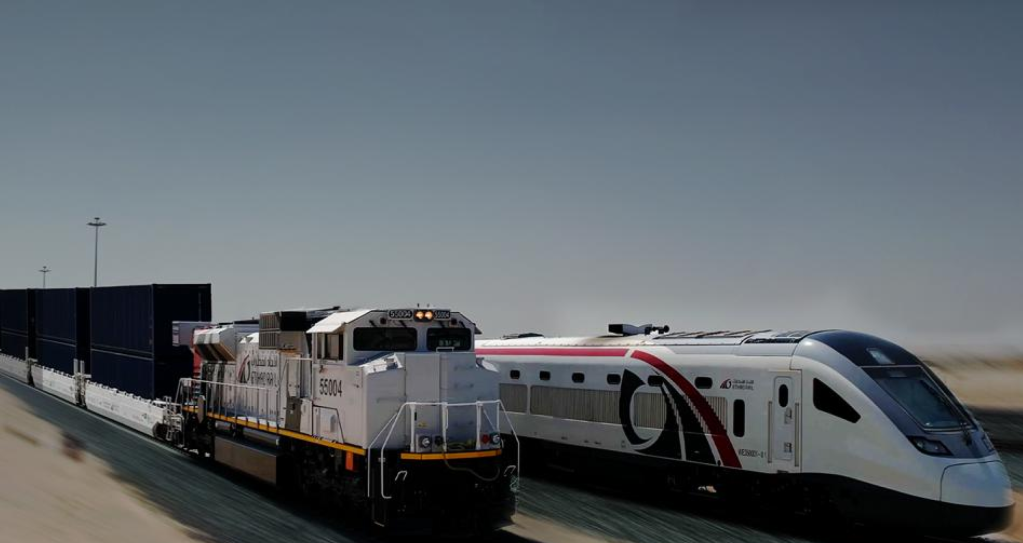Imagine travelling from Dubai to Abu Dhabi in the time it takes to finish a cup of coffee. That dream is about to become a reality. By 2026, the Etihad Rail Dubai to Abu Dhabi route will make this fast journey possible—just 25 minutes between the two cities. This groundbreaking high-speed rail project will not only save time but also change the way people live, work, and move across the UAE.
The Etihad Rail project, often described as the backbone of the UAE’s future transport network, is designed to connect all seven emirates through a state-of-the-art train system. It’s a bold vision, backed by years of planning and billions in investment, and it’s speeding toward completion.
How Etihad Rail Will Cut Travel Time
Currently, a road trip between Dubai and Abu Dhabi takes around 90 minutes, depending on traffic. Etihad Rail’s passenger trains will reduce that time to just 25 minutes. Trains will travel at a top speed of 200 km/h, making them a strong alternative to driving or flying between the two cities.

The trains will offer modern seating, Wi-Fi, entertainment systems, and food services—bringing air-travel-level comfort to the ground.
For daily commuters, tourists, and business travellers, this change means fewer hours on the road and more time doing what really matters.

Stations and Routes: Connecting the Emirates
The Etihad Rail network is expected to span 1,200 kilometres, linking major cities across the UAE, including:
- Abu Dhabi
- Dubai
- Sharjah
- Ajman
- Ras Al Khaimah
- Fujairah
- Umm Al Quwain
The Dubai to Abu Dhabi segment is part of the Stage Two development. This section will connect Al Ghuwaifat (on the Saudi border) to Fujairah Port, running through Abu Dhabi, Dubai, and the Northern Emirates. Passenger services will be supported by multiple strategically located stations, including one in Al Sufouh (Dubai) and ICAD (Abu Dhabi).
A Boon for Daily Commuters and Businesses

The Etihad Rail Dubai to Abu Dhabi service is especially good news for daily commuters who currently spend a large part of their day stuck in traffic. With the train, workers can reach their offices in another emirate in less than half an hour.
Businesses will also benefit. Faster travel will boost collaboration, make inter-city meetings easier, and attract more professionals to consider jobs across different emirates without needing to relocate.
Environmental and Economic Impact
Etihad Rail is not just about speed and convenience—it’s also a key part of the UAE’s sustainability goals.
Each train journey can replace hundreds of cars on the road, reducing carbon emissions by up to 80% per passenger kilometer compared to cars. This shift supports the UAE’s commitment to becoming carbon-neutral by 2050.
On the economic side, the rail project is expected to contribute AED 200 billion to the UAE’s economy by 2050. Thousands of jobs are being created in logistics, construction, and technology as the project expands.
What to Expect Onboard Etihad Rail
Passengers can look forward to a smooth, high-tech experience. Here’s what you can expect:
- Comfortable seating with spacious legroom
- Luggage storage compartments
- Free high-speed Wi-Fi
- Onboard entertainment options
- Snacks and beverage services
- Designated areas for families and business travellers
The design focuses on inclusivity and accessibility, with special spaces for people of determination, elderly passengers, and families with children.
Ticket Prices: What Will It Cost to Ride?
While the final pricing hasn’t been revealed, officials say tickets will be affordable and competitive with other transport options. Given the time saved and onboard comfort, many are already saying it’s worth every dirham.
Discounted passes may also be available for students, seniors, and frequent travellers.
Freight Services Already in Motion
While passenger services are expected to launch by 2026, freight operations are already running. Etihad Rail’s freight trains are currently transporting goods such as:
- Construction materials
- Industrial chemicals
- Containers from ports to warehouses
This has already removed thousands of trucks from UAE highways, reducing traffic and pollution.
How Etihad Rail Will Change the UAE’s Future
The Etihad Rail Dubai to Abu Dhabi route is more than just a transportation upgrade—it’s a lifestyle upgrade. It’s expected to:
- Make regional travel more attractive
- Encourage business expansion across emirates
- Support tourism by connecting major attractions
- Reduce car dependency
- Lower greenhouse gas emissions
- Enhance the UAE’s global image for innovation
Voices From the Public

Residents across the UAE have shared their excitement about this fast, futuristic mode of transport. Many say they look forward to:
- Shorter commutes
- Safer journeys
- More time with family
- Easier access to events, beaches, and city centers
For example, Noor, a marketing manager who lives in Abu Dhabi and works in Dubai, says, “Right now, I spend over three hours a day commuting. If I can cut that to just under an hour round-trip, it will change my life.”
Conclusion: UAE’s Leap Into the Future
The Etihad Rail Dubai to Abu Dhabi route is a major step in the UAE’s journey toward a smarter, faster, and more sustainable future. By 2026, what once took nearly two hours by car will take only 25 minutes by train.
This is not just a win for transportation—it’s a win for people, businesses, and the planet.
As the UAE continues to build at lightning speed, projects like Etihad Rail show how innovation and vision can reshape a nation’s future.
Read More: Jaywan: UAE’s New Domestic Card Payment Scheme Explained














